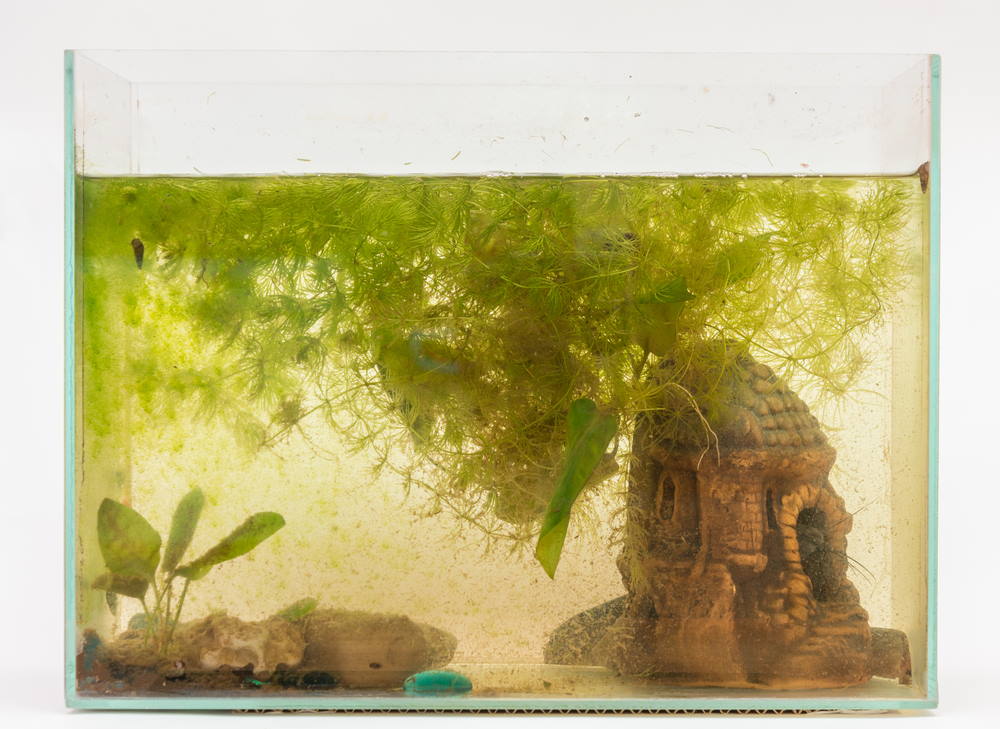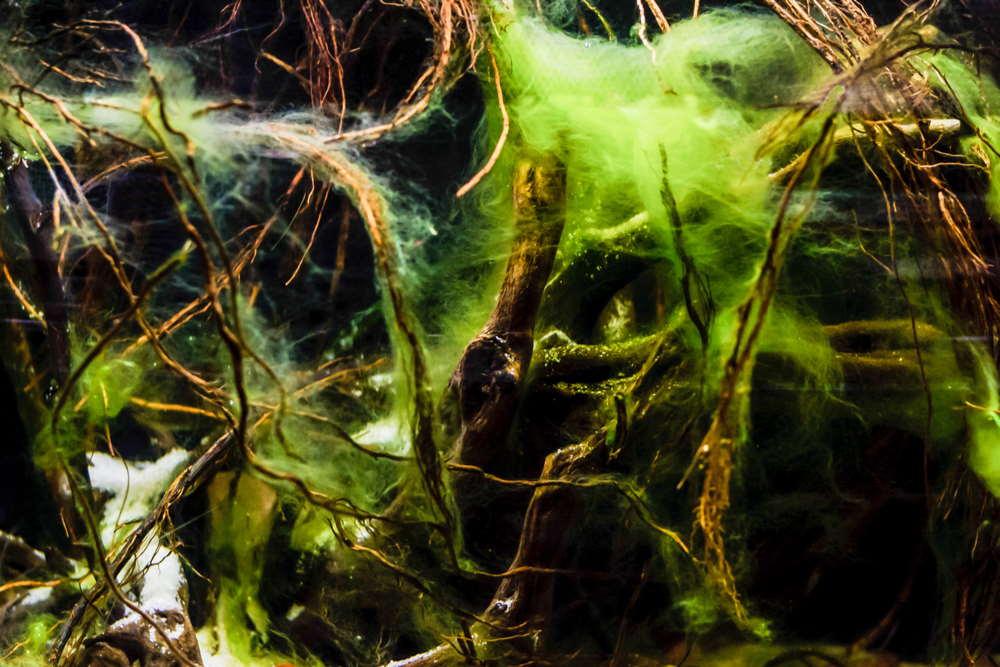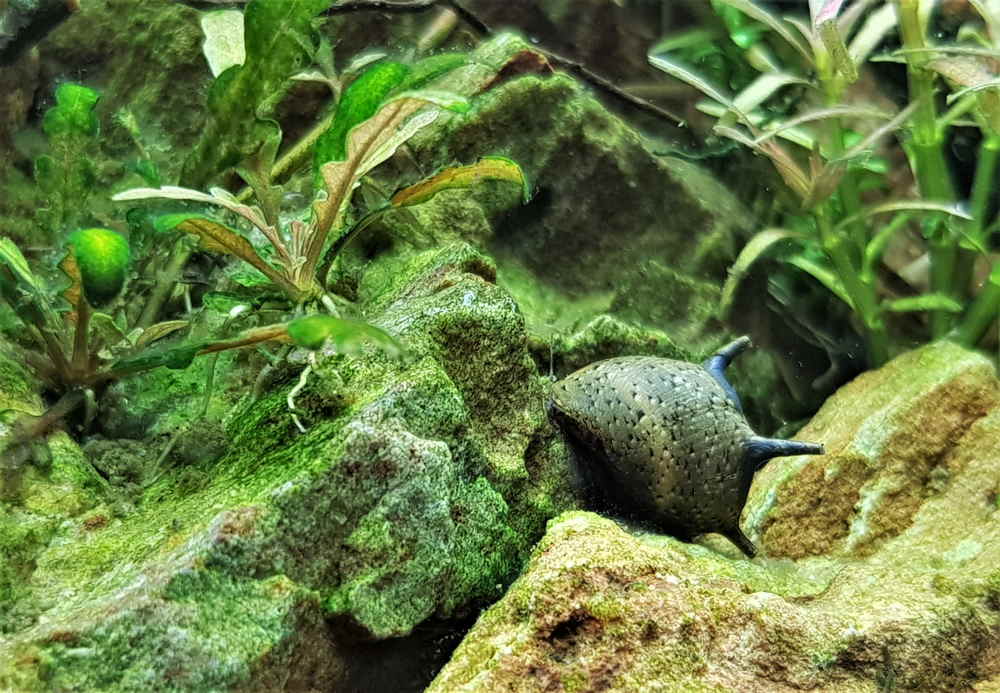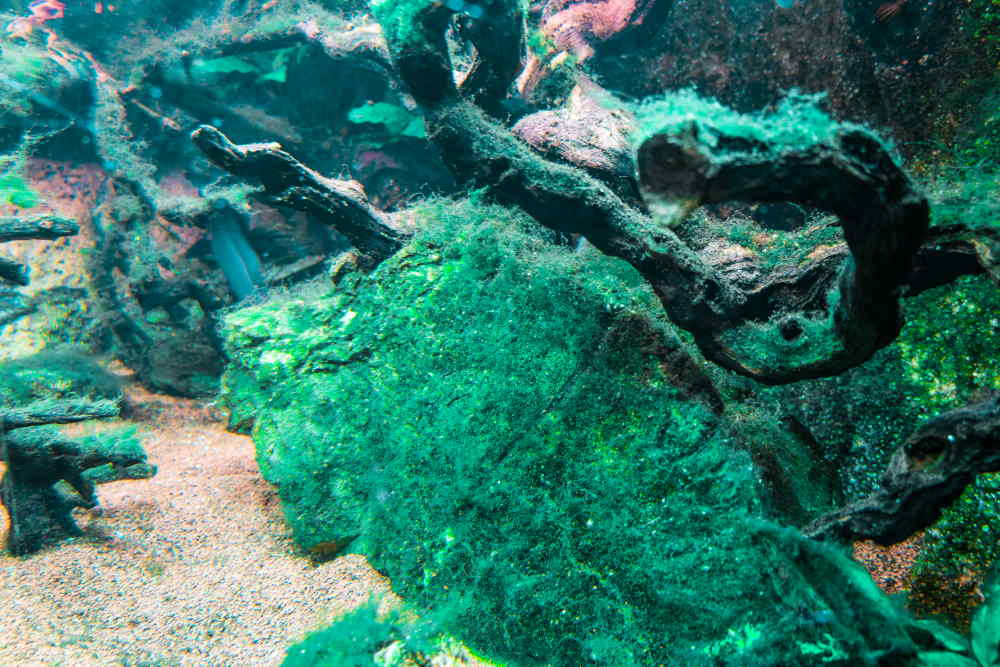How To Treat Hair Algae In Planted Tank
Practise you dream of having a beautiful aquarium just end up constantly fighting to keep algae at bay? It's a familiar struggle that many of united states have been through, and then in this article, permit's get a better understanding of the root causes of algae, the most mutual types plant in freshwater aquariums, and how to gain the upper hand.
Is Algae Bad for a Fish Tank?
Reverse to pop belief, algae are not evil. Like plants, they use photosynthesis to convert light and organic nutrients in the water (such as fish waste matter) into new algae growth. That ways they as well produce oxygen during the daytime and swallow it at nighttime. Unlike plants, algae are a less complex lifeform and therefore can survive in "worse" conditions than plants, meaning they can absorb more wavelengths of light and consume dissimilar compounds that plants can't apply.
Algae is actually a skilful affair for your aquarium'southward ecosystem because many fish and invertebrates like to swallow information technology and it helps clean the water as a course of filtration. Plus, certain algae tin can await attractive and make an aquarium seem more natural. However, about people don't like their appearance, especially in planted tanks, since it blocks the scenery and viewing area in a fish tank.
The reality is that there is no such thing every bit a perfect planted aquarium that is 100% free of algae. Imagine you have a neighbor with a well-groomed lawn of grass. Even they will get the occasional weed (like algae in an aquascape) that must exist dealt with. Now let's suppose your not-as-prissy lawn has five dandelion weeds that have grown to one foot tall. If you mow the lawn, then it volition appear equally if yous accept no weeds. In the same way, nosotros want to larn how to appropriately control algae so that you can't see it and the tank looks like practically spotless.
Why Does My Fish Tank Have So Much Algae?
Algae is acquired by an imbalance of nutrients and lighting in your aquarium. This elementary argument can be a fiddling difficult to unpack, simply basically, your plants need just the right amount of lighting and nutrients for optimal growth. If you give them too much light and not plenty nutrients every bit building blocks to grow, the algae will have advantage of the excess light and multiply. If you provide a lot of nutrients but non enough light (which regulates how fast plants can utilize the nutrients), then algae volition accept reward of the extra nutrients. To brand matters worse, achieving a perfectly balanced tank is nearly impossible considering even if you balance everything today, your plants volition continuously abound or you lot will prune them, thus changing the amount of nutrients and lighting they need.
How Exercise I Become Rid of Algae in My Fish Tank?
Since you will always have some imbalance betwixt lighting and nutrients, the goal is to become your aquarium every bit close to being counterbalanced as possible, so employ an algae-eating coiffure to fill in the residue of the gap. We have institute this one-two punch strategy quite effective at greatly reducing algae to unnoticeable amounts. In the following section, nosotros'll be discussing the half-dozen nigh common types of aquarium algae with targeted tactics of dealing with them.
Brown Diatom Algae
Brown (and sometimes light-green) diatom looks like a dusty, flour-like substance covering your aquarium walls, substrate, and other surfaces. Because information technology's so soft, it easily rubs off with an algae scrubber sponge, and many animals (like otocinclus catfish, snails, and shrimp) like to eat it. Diatom algae is most unremarkably seen in newly planted tanks and is oft caused by high levels of phosphates and silicates. It's one of the simplest algae to get rid of considering if you merely give it some fourth dimension, the plants volition naturally consume the backlog phosphates and silicates, and make clean-up crews love to feed on it.

Brownish algae
Black Beard Algae (BBA)
BBA is one of the about problematic algae that people meet because not many things eat it. Every bit per its name, it grows in very thick, bushy clumps that are unremarkably black or grayness in color (but sometimes crimson or brownish). This algae likes to grow on driftwood, aquarium decor, and plants, and if left unchecked, information technology can completely engulf an aquarium in one to two years. Unfortunately, in that location'due south a lot of unlike things that can contribute the growth of BBA, so in that location'due south no i uncomplicated way to treat it.

Black beard algae
If you don't like the expect of the algae, you can try adding Siamese algae eaters, Florida flagfish, or amano shrimp (although the shrimp take a long time to eat it unless you have an ground forces of them). Some people plow to chemical treatments, such as using liquid carbon to direct spray on the BBA for tough cases or to dose the entire aquarium'southward water cavalcade for mild cases. Simply be careful because sure plants like vallisneria are sensitive to liquid carbon.
Another chemical treatment is to spray the BBA-infested establish or decor with 3% hydrogen peroxide (purchased from your local drugstore) exterior of water, let it sit for 5 minutes, rinse off the chemical, and put the detail back in the aquarium. The dying algae turns red or articulate, and animals may eat it in its weakened state. Just remember that in that location are no quick fixes – BBA can accept six to viii months to get established, and so expect information technology to take at to the lowest degree that long to become rid of.
Hair Algae
In this category, we're referring to the many types of algae that expect like wet pilus when you take them out of the aquarium (eastward.1000., hair algae, staghorn algae, string algae, and thread algae). These algae tin can be problematic because they grow so apace or are difficult to get rid of. They're mostly acquired by an excess of certain nutrients (such equally iron), too much light, or not enough nutrients (to match the long lighting period). Therefore, attempt decreasing your lighting menstruation, increasing fertilization, or decreasing atomic number 26. Siamese algae eaters, amano shrimp, molly fish, and Florida flagfish are good candidates to use as clean-upwardly crew. Yous can also help them by manually removing large clumps using a toothbrush.

Hair algae
Green Spot Algae (GSA)
GSA looks like tiny, hard dark-green spots on the aquarium walls and slower growing plants that are very difficult to clean off. A lot of things tin can cause an outbreak, such every bit too much light or an imbalance of phosphate. Endeavour using a drinking glass-rubber or acrylic-safe algae scraper (with the blade zipper) to remove the algae from aquarium walls.
Nerite snails are also a adept first line of defense since they seem to like eating GSA. But be aware that, while this species does not reproduce in freshwater aquariums, they will lay white eggs (similar to fiddling sesame seeds) all over the aquarium, and some people don't similar the look.

Nerite snail eating green spot algae
Bluish-Green Algae (BGA)
BGA is technically not a type of algae, but rather a cyanobacteria that grows like a slimy blanket coating the substrate, plants, and decor. It comes with a rather distinctive olfactory property that many fish keepers acquire to recognize earlier the bacterial colony is fifty-fifty visible. No i is 100% certain what causes BGA, but in general, improved aquarium budget and increased water apportionment with an air stone or powerhead can assistance go on it away. Algae eaters typically will non eat the stuff, so don't count on their help in this case.

Blueish-dark-green algae or cyanobacteria
Since BGA is photosynthetic, you lot can endeavour to blackout the tank for a week, just this can be hard on the plants. Instead, nosotros recommend manually removing as much of the BGA equally possible, doing a water change while vacuuming the substrate, and so treating the tank with antibiotics. Use one package of Maracyn (which is fabricated of an antibody called erythromycin) per 10 gallons of water, and let the aquarium sit for ane week before doing some other water change. Repeat the handling one more time for stubborn cases. For more information on treating BGA, read our full article here.
Light-green H2o
If your aquarium water looks like pea soup, you probably accept light-green water, which is caused past a proliferation of free-floating, unmarried-celled phytoplankton. Unfortunately, they replicate and then quickly that y'all cannot flush them out with big water changes. Dark-green h2o can come from too much lighting (peculiarly if the tank gets direct sunlight one-time during the day), an excess of nutrients (such as accidentally double-dosing fertilizers), or an ammonia spike (such as from a new tank that has not been cycled all the same or overfeeding by a pet sitter). To get rid of green water, you can blackout the tank for at to the lowest degree a week, which is hard on your plants. Another option is to purchase a UV sterilizer, which will kill off the algae within two to three days.

Green water
How to Balance Lighting and Nutrients
When it comes to fighting algae, everyone e'er assumes yous must decrease lighting and/or nutrients, simply sometimes the better course of action is to increment one or both of them. Let'southward go back to our case where you have a greenish lawn with five dandelions. It doesn't make sense to finish watering your lawn (eastward.k., stop using lighting and fertilizers) just to get rid of a few weeds because you'll probably end up killing your grass too. Instead, we bargain with the weeds past pulling them out (e.grand., manually removing the algae or getting a snail to consume them) and/or feeding the lawn more and so that it'south healthier and the weeds won't come up back every bit readily.
Your focus should be on successfully growing lots of plants, non necessarily on eliminating algae at all costs. To balance the aquarium, put your light on an outlet timer every bit a constant cistron, and and then gradually increase or decrease your nutrient levels with an all-in-1 fertilizer. Do not brand multiple or drastic changes all at one time because it takes at to the lowest degree two to three weeks to see whatever deviation in your plants and determine whether or not your deportment helped remainder the aquarium. (For more detailed troubleshooting steps, encounter our plant nutrient deficiency article to learn which specific nutrients your plants might be missing.)
The Cyberspace claims that if yous practice everything perfectly, your tank will never get algae, merely in our experience, this is highly unlikely in the real world. Even Takashi Amano, known as the father of modern aquascaping, popularized the usage of the algae-eating amano shrimp to keep his planted tanks make clean and cute. So, don't be afraid to bring in the right algae eaters to help out while yous're trying to gear up your lighting and nutrient balance issues. Best of luck on your plant-keeping journeying!
Source: https://www.aquariumcoop.com/blogs/aquarium/aquarium-algae
Posted by: whiteleyanyther.blogspot.com


0 Response to "How To Treat Hair Algae In Planted Tank"
Post a Comment